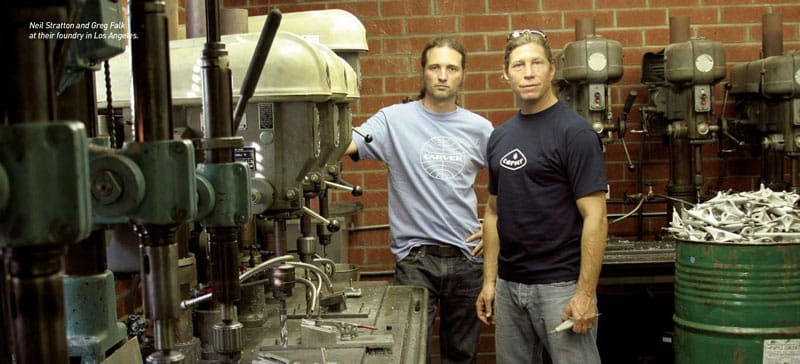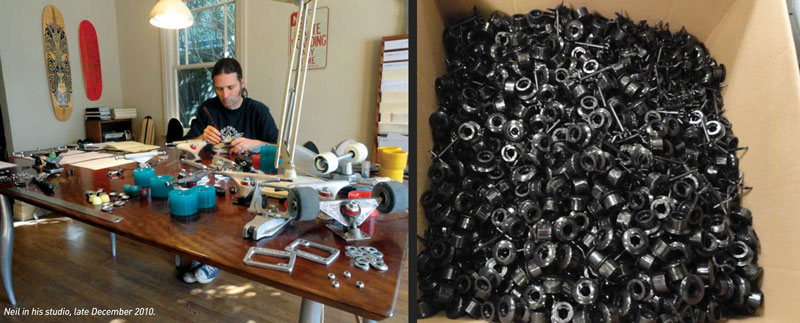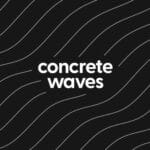The following is an interview with Greg Carver, originally published in Concrete Wave Magazine Vol 9 No 4 (Winter 2011)

How did you get involved in making skateboard products?
I remember making my first skateboard in Hawaii when I was 8 years old. My oldest scar is on my left hand where the screwdriver slipped off the shallow slot in the flathead kingpin and I stabbed my hand with it. When I settled down in Venice almost 20 years ago, I met Greg [Falk] and we became best friends. We’re both artists and creators, and we were surfing and skating a lot together, and the idea for a skateboard that really surfed was just a natural extension of who we were and what we were doing.
I started welding these swing-arm trucks to give the board the kind of snap and pump we were feeling on our surfboards. We’d ride them until they’d break, and then talk endlessly about how to make them better the next time around. We did that for years before we really had something, and at that point we knew it was time to take it past the handmade and into production.
We partnered with a foundry and started making trucks. We were incredibly naive and optimistic, and we thought if we just made them it would blow up; our friends loved riding them, too, so it wasn’t just us. Well, we couldn’t have been more wrong.
We learned that the skateboarding market was the most closed market ever, and we were on the outside with the “wrong” product. We tried to interest every truck company we could to give our trucks a chance, but all we got was “we only want to spend our money on what we know sells already.” At that point we had a production model ready to go and we thought, well, this is too cool, and if no one is going to pick it up then we’ll just have to start a skateboard company and do it ourselves.


How many years have you been involved with it?
It’s been almost 15 years since we started Carver. At the time we had no idea how ahead of the curve we were with the dual-axis truck and the looser nose concept. We truly thought that it would be just another couple of years and the longboard market would blow up, and that surfskate would be huge too.
Developing this in Venice we were keenly aware of the roots of surfskate with CR Stecyk and Dogtown … so we saw the start of the longboarding scene and how much fun it all was, and we thought it had to catch on any minute. It’s a good thing for us that it took so long, because the way we did it – where we learned what we needed to as it came up – was not the most efficient way to grow.
Had we not had all these years to grow up as entrepreneurs we could have been outrun by any number of better businesses, and we would have been the “we had the idea first but they stole it” sad-sack story. We’re not out of those woods yet, but we’re stronger than we’ve ever been, and the market still has plenty of room to grow. We’ve essentially been forced into every growth stage along the way just because it was just the next thing that had to happen. We’ve just gone through a major restructuring where we lost our foundry partner, and Greg and I had to restart from scratch a few years ago.
We built another factory and learned how to run it. It’s been pretty stressful, but it’s also been amazing. We’ve been able to learn from the mistakes of the past and create a culture for the company that’s as considered and well designed as the products themselves.
What do you see happening to North American skateboard manufacturing?
For a while it looked as though China was the inevitable solution to stay competitive in the marketplace, but we’ve always made things ourselves and been wary of the issues that come with overseas manufacturing. When we had to rebuild several years ago we explored the option of making our trucks in China. We were a couple of artists overwhelmed with the cost and complexity of building a brand and a new factory, and the idea of having trucks arrive finished in boxes seemed very appealing.
Ours is a particularly difficult truck to make. It was cheaper [in China] too, but there were many reasons not to do it as well. We weighed the decreased control of a faraway vendor, the long lead times, the big minimums, and the plain fact that we’d have to take part in the exodus of American manufacturing, and it was very dismaying. So we decided to see if we could do it here and still succeed on a business level.
We refinanced our homes when loans were still loose and were able to finance the rebuild on bubble money; otherwise we couldn’t have done it. Greg actually called me just before the bubble burst and told me that some friends had lost their lines of credit and that banks were starting to reel it all in. We went to the bank that day and borrowed everything we could in cash and deposited it in a different bank. A week later it all dried up. We took the money and rented a warehouse nearby, tooled up and started making trucks and skateboards. Just as the loan money ran out we got some big orders and were able to stay afloat, and we’ve been riding that growing swell since.
We’re not opposed to making things overseas; it can be good for skaters to offer a variety of price points and levels of quality. Beginners can get into skating with a cheaper board and then upgrade as they demand better equipment. Plus the profits still flow through an American brand. But we feel it’s essential to keep a high-end, American-made skateboard alive and well. It’s also a part of our identity as a country to make the things we need, and it’s a shame that we’ve given that away for short-term profits. We hope that in the near future the costs of manufacturing overseas will increase as labor costs rise to accommodate higher global standards, and that cost difference will no longer be enough to justify the loss of jobs and pride. Then making things locally will no longer be a question but an advantage.
